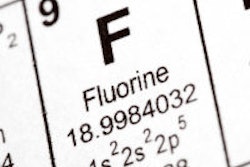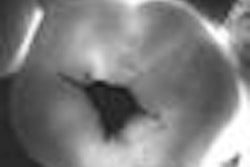
Quantitative laser fluorescence (QLF) -- which noninvasively measures the loss of fluorescence intensity in areas of enamel hypomineralization -- could be a useful tool in epidemiological studies designed to quantify fluorosis and distinguish between fluoridated and nonfluoridated populations, according to a new study in BMC Oral Health (November 1, 2012).
The last several decades have seen a decline in the prevalence of dental caries through the use of fluoridated community water supplies and fluoridated oral care products, noted the study authors, from the University of Manchester School of Dentistry, University of Newcastle School of Dental Sciences, and Colgate-Palmolive.
"However, this reduction in caries has also been associated with concerns regarding increased prevalence of dental fluorosis in both fluoridated and nonfluoridated communities," they wrote.
There is a need to measure the prevalence and severity of fluorosis within populations for surveillance purposes, the researchers contended in a related study published earlier this year (BMC Public Health, May 20 2012). In the U.K., for example, health authorities who have added fluoride to water systems are legislatively obligated to measure and report dental fluorosis prevalence, they noted.
In that study, they employed both polarized white light and QLF to measure enamel fluorosis in 164 children at the Chiang Mai University dental school in Thailand. Among other findings, they found that "the automated software analysis of QLF images demonstrated significant correlations with the clinical examinations."
Two U.K. communities
For the current study, the researchers worked with participants of an epidemiological survey that had assessed caries and fluorosis prevalence and severity in two areas in Northern England: Newcastle upon Tyne, which has a fluoridated community water supply, and Greater Manchester, which does not.
A total of 1,774 individuals (905 in Newcastle, 869 in Manchester) were selected. All were healthy males and females, ages 11 to 13 years old, who had lived in these communities all their lives.
Each participant had standardized conventional digital photographs taken of the maxillary central incisors after the teeth had been cleaned and dried for one minute. The images were exported to a computer and scored for fluorosis using the Thylstrup & Fejerskov (TF) index.
The QLF equipment featured a custom-built stabilizing unit with an adjustable head and chin support and a camera focus platform connected to a high-resolution 3 CCD camera (Jai M91P) and illuminator (a custom LED array emitting at 405 nm).
The researchers also used a convex hull analysis software package originally designed to quantify stain on teeth. The software was designed to detect diffuse areas on the tooth surface using an algorithm based on a convex hull to detect and quantify the diffuse areas of hypomineralization associated with fluorosis.
Confounding factors
After analyzing QLF images of the maxillary central incisors and corresponding photographic fluorosis scores using TF index for the 1,774 study subjects, the QLF data demonstrated a significant correlation with TF index scores from the photographs (p < 0.0001).
However, a number of confounding factors -- such as the presence of extrinsic stain or increased enamel translucency on some subjects without fluorosis or at low levels of fluorosis severity -- had an adverse impact on tooth fluorescence and hence the outcome variable, the researchers noted.
"This, in conjunction with an uneven distribution of subjects across the range of fluorosis presentations, may have resulted in the lower than anticipated correlations between the fluorescent imaging metrics and the photographic fluorosis scores," they wrote.
However, QLF was able to discriminate between a fluoridated and nonfluoridated population (p < 0.001), they added.
"As dental fluorosis is not endemic in the U.K., the data did not present a uniform distribution of presentations of severity," the study authors wrote.
Even so, the results of this study suggest that QLF has the ability to reliably quantify fluorosis in an epidemiological setting, assisted by clinical diagnosis.
"QLF has the potential to monitor fluorosis longitudinally at both a population and individual level," they concluded. "Despite confounding factors, the fluorescence imaging system may provide a useful, objective, blinded system."



















